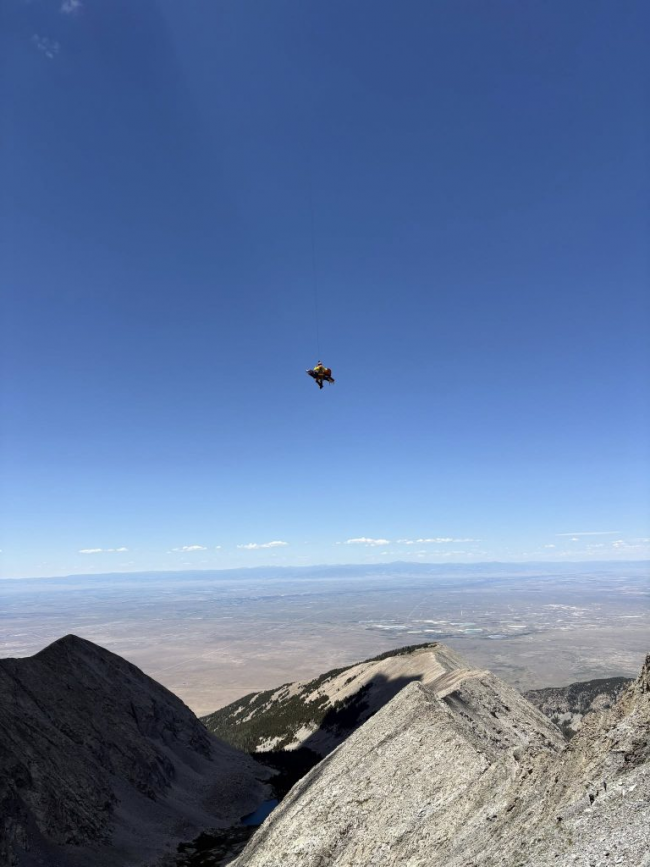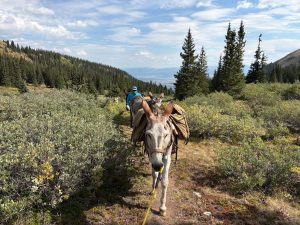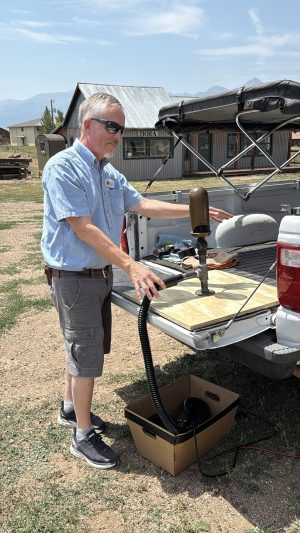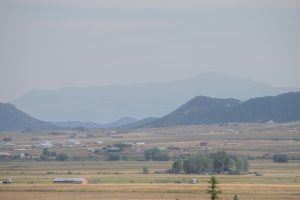The dark blue, almost black, of the morning twilight was only punctuated by the headlamps of three hikers as they reached the polished granite chute known as the “Hourglass” on the western flank of Little Bear Peak. It was Sunday, July 27, and while it was the height of summer, the air at 13,300 feet was frigidly cold. Husband and wife Gianna and Jake Spitaliere decided to take a short break and eat a snack before heading up the Hourglass. They met another hiker, Ben Jamieson, who was also attempting the early morning summit of the 14,041-foot peak, and they chatted for a few moments.
The Hourglass is notorious not because of its steepness, it’s a class four, meaning no technical rope is required, but because the smoothed granite is as slick as ice when it gets wet. Furthermore, the solid granite rock gives way to crumbling sedimentary rock as hikers exit the chute. It is easy to kick loose stones and send them plunging into the Hourglass. The boulders are so loosely held together from the constant freeze/frost cycle that rockslides are a regular occurrence even in the absence of the tread of a hiker’s boot. Being the first group up the peak in the morning has turned the Hourglass almost into a type of race between those who want to summit, and for the Spitalieres and their new acquaintance Jamieson, they all knew they were the first.
As the three hikers got out their snacks, the world turned upside down for all three. “In those few seconds, we heard what I can only describe as the loudest thunder imaginable from above,” Gianna recounted. Rocks had worked free on their own from above the Hourglass, and as the three dodged for cover, Gianna could see boulders the size of dishwashers fly towards them. Gianna and Jake darted behind the solid cliff outcroppings to the left of the Hourglass entrance. Ben, however, was further out, and as he tried to dodge to the right, a boulder the size of a microwave caught him in the head midstride. Through the dim morning light, Jake spotted Ben tumble head over heels after being struck senseless by the rock for over 20 feet down the side of the steep mountain.

With the flinty smell of rock dust still in the air, Jake was able to find his phone and call 911. Cell phone service in the Sangre de Cristo Mountain Range, where Little Bear Peak is located, is sparsely populated, and cell phone service is never certain. In addition, the Spitalieres activated their Garmin InReach GPS. These devices communicate with overhead satellites and send out detailed coordinates to search and rescue teams when activated. For the next seven hours, the Spitalieres, along with a coordinated effort by dozens of people, would work against the clock of Ben’s life-threatening injuries to get him off the mountain.
The Spitalieres quickly located Ben’s limp form in the growing light of the July dawn, and with the help of 911 and the Alamosa Volunteer Search and Rescue (AVSAR), they worked to gauge Ben’s condition and stabilize him over the phone. The first and biggest stroke of luck is that Jake is an Emergency Room Nurse.
The moment the call came into the emergency dispatch center, various teams of the AVSAR were activated to reach Ben. The location of the trailhead to Little Bear Peak is just a mile away, as the crow flies, near a tiny Alpine lake, amusingly named Lake Como, just below the timberline. The road is so rough and extreme that most choose to park three miles, and several thousand feet lower, to the west of the lake. AVSAR took a two-pronged approach to getting help to Ben. First, they contacted the Air National Guard and Reach Air Medical to start the coordination of inserting a team at the base of the peak to hike up to Ben and work to stabilize him. Another ground team of ten members would start up the treacherous road using specialized rock-climbing vehicles that could navigate the route. This ground team would redirect hikers away from the Hourglass and set up a base that would serve as a field medical location and prepare to move Ben off the mountain if a helicopter hoist rescue proved unsuccessful.

About an hour and a half after the fall, another group of six hikers reached the scene of the rockfall and had with them bivy bags to help warm Ben’s body up from the cold.
A brief moment of panic set in sometime mid-morning as the helicopter performing the hoist operation was experiencing mechanical issues, and it was uncertain whether the chopper would be able to hoist Ben off the rocky mountain slope. The air is so thin at 13,300 feet that hoist operations are only performed in the most extreme conditions, and even then, weather or mechanical issues can delay the operation. The ground crew at Lake Como began the ascent up the mountain to retrieve Ben. However, it came over the radio that the Air National Guard was en route.
Helicopter hoist operations almost defy belief, and the crew that flew to pick up Ben was no exception. Two technicians mounted inside a Black Hawk helicopter were inserted first by rappelling down from the hovering craft. Ben was then placed in a specialized bag for the hoist. Dangling by several hundred feet of rope, Ben and one technician were hoisted thousands of feet above the mountain to the emergency helipad AVSAR had created at Lake Como. Ben received more care and stabilization at the temporary helipad and was then transferred to the waiting Reach Air Medical Helicopter and flown to Colorado Springs, some 100 miles away.
For the Spitalieres, they still had to walk off the mountain, and 16 hours after the crisis began, they made it out of the wilderness. Many wondered what Ben’s condition was, but Search and Rescue organizations never share those personal medical details.
However, a few days later, on July 31, a GoFundMe account was created for Ben’s medical and family costs, and this donation website had the first updates since July 27. When Ben arrived at the Colorado Springs trauma-care center, he was unconscious and barely able to breathe on his own, and was placed on a ventilator. Despite how dire his condition seemed to be, by the next day, he was breathing on his own, and while he was still unconscious, he started to respond to some commands to move his limbs. The rock that hit him in the head had done serious injury, but the family was becoming cautiously optimistic. By August 5, he was able to open his eyes and had regained consciousness, but was still in critical condition and was unable to speak due to a tracheostomy to keep him breathing.
Despite the fall, Ben’s father, John, stated he had only broken two bones. During an interview with KRDO out of Colorado Springs, he said, “Nightmare. Yeah, a nightmare near death. Bruised, battered, purple. We could not believe that he only broke two bones.” The family also stated, “First and foremost, we want to acknowledge that God’s hand has been in every part of this journey…from the accident to the rescue and now into Ben’s recovery. We’ve felt His presence and provision every step of the way. We are especially grateful to Jake and Gianna Spitaliere, who witnessed the accident on Little Bear and immediately called 911. They remained with our son through the entire seven-hour hoist rescue at 13,300 feet. Their courage, compassion, and steadiness during such a terrifying experience will never be forgotten. They, along with the incredible search and rescue team, saved Ben’s life.”
As of August 10, Ben is now able to speak some and sit upright in a specialized chair, and by all accounts, will recover.
Little Bear Peak sits at the southern end of the Central Sangre de Cristo Mountain Range and is part of the Sierra Blanca Massif to the Southwest of Gardner. At least four different Search and Rescue Teams from Custer County, Huerfano County, Fremont County, Chaffee County South, Saguache County, and Alamosa work together to help hikers in the Sangre de Cristo Mountain Range. While Alamosa was the lead on this rescue, you will often see teams from both sides of the range communicating and working together, along with help from larger state agencies, to save lives.

These organizations are volunteer and they never charge for the work they do. Be sure to support them with direct donations to the Search and Rescue team of your choice or by purchasing a Colorado Outdoor Recreation Search and Rescue Card, which helps fund these organizations.
Lastly, wearing a helmet while mountaineering in rocky areas can help limit damage from falling rocks. Ben was not wearing a helmet, but the Spitalieres were.
–Jordan Hedberg
One video that helped understand the route and dangers to Little Bear Peak was Virtual Sherpa.





